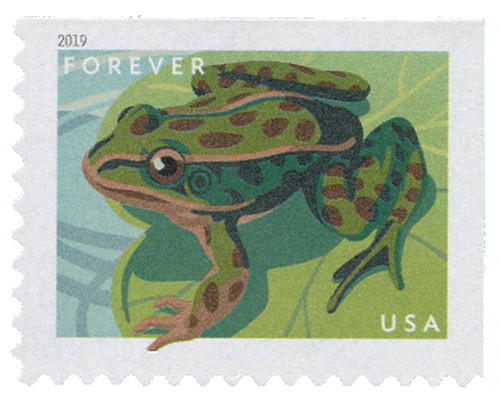
# 5398 - 2019 First-Class Forever Stamp - Frogs: Squirrel Tree Frog
US #5398
2019 Squirrel Tree Frog – Frogs
• One of four stamps commemorating frogs of North America
Stamp Category: Commemorative
Set: Frogs
Value: 55¢ First Class Mail Rate (Forever)
First Day of Issue: July 9, 2019
First Day City: Boise, Idaho
Quantity Issued: 200,000,000
Printed by: Banknote Corporation of America
Printing Method: Offset
Format: Double-sided Booklet of 20
Tagging: Phosphor Tagged Paper, Block Tagged
Why the stamp was issued: To showcase the beauty and adaptability of the squirrel tree frog.
About the stamp design: Pictures a digital illustration of the squirrel tree frog. Original artwork by Nancy Stahl consisting of shades of green and brown to represent how this frog blends in with its native environment.
First Day City: The First Day of Issue Ceremony was held at the Morrison Knudsen Nature Center in Boise, Idaho.
About the Frogs set: Includes four stamps showcasing the beauty and diversity of different North American frog species: Pacific tree frog, northern leopard frog, American green tree frog, and squirrel tree frog. Original artwork by Nancy Stahl consisting of shades of green and brown to represent how these frogs blend in with their native environments.
History the stamp represents: The squirrel tree frog’s name comes from the call it makes, which sounds like a squirrel chattering. It’s also called “rain frog” because it’s commonly heard during or after a rainstorm.
A squirrel tree frog is small, only 1-1.5 inches long, and is usually bright green. However, it can change colors to yellowish brown or brown, to blend in with its surroundings. These frogs live in the southeastern United States and were introduced to the Bahamas in the early 70s.
This small frog is found around wells, under the eaves of buildings, and near outside lighting at night. The squirrel tree frog stays in these areas so it can prey upon unsuspecting bugs that are attracted to the light. It is an aggressive predator and eats many different invertebrates (animals with no spine). Some have even been spotted near cow dung, snacking on insects that are attracted to manure.
The male frogs head toward water to mate from April to August. Females lay eggs in temporary water such as ditches, puddles, and shallow ponds. These have fewer predators than other water sources. The eggs sink to the bottom and hatch within a month. The tadpoles transition to frogs within a few days. Due to the adaptability of this frog, it is a species of least concern and will be around for years to come.
US #5398
2019 Squirrel Tree Frog – Frogs
• One of four stamps commemorating frogs of North America
Stamp Category: Commemorative
Set: Frogs
Value: 55¢ First Class Mail Rate (Forever)
First Day of Issue: July 9, 2019
First Day City: Boise, Idaho
Quantity Issued: 200,000,000
Printed by: Banknote Corporation of America
Printing Method: Offset
Format: Double-sided Booklet of 20
Tagging: Phosphor Tagged Paper, Block Tagged
Why the stamp was issued: To showcase the beauty and adaptability of the squirrel tree frog.
About the stamp design: Pictures a digital illustration of the squirrel tree frog. Original artwork by Nancy Stahl consisting of shades of green and brown to represent how this frog blends in with its native environment.
First Day City: The First Day of Issue Ceremony was held at the Morrison Knudsen Nature Center in Boise, Idaho.
About the Frogs set: Includes four stamps showcasing the beauty and diversity of different North American frog species: Pacific tree frog, northern leopard frog, American green tree frog, and squirrel tree frog. Original artwork by Nancy Stahl consisting of shades of green and brown to represent how these frogs blend in with their native environments.
History the stamp represents: The squirrel tree frog’s name comes from the call it makes, which sounds like a squirrel chattering. It’s also called “rain frog” because it’s commonly heard during or after a rainstorm.
A squirrel tree frog is small, only 1-1.5 inches long, and is usually bright green. However, it can change colors to yellowish brown or brown, to blend in with its surroundings. These frogs live in the southeastern United States and were introduced to the Bahamas in the early 70s.
This small frog is found around wells, under the eaves of buildings, and near outside lighting at night. The squirrel tree frog stays in these areas so it can prey upon unsuspecting bugs that are attracted to the light. It is an aggressive predator and eats many different invertebrates (animals with no spine). Some have even been spotted near cow dung, snacking on insects that are attracted to manure.
The male frogs head toward water to mate from April to August. Females lay eggs in temporary water such as ditches, puddles, and shallow ponds. These have fewer predators than other water sources. The eggs sink to the bottom and hatch within a month. The tadpoles transition to frogs within a few days. Due to the adaptability of this frog, it is a species of least concern and will be around for years to come.









